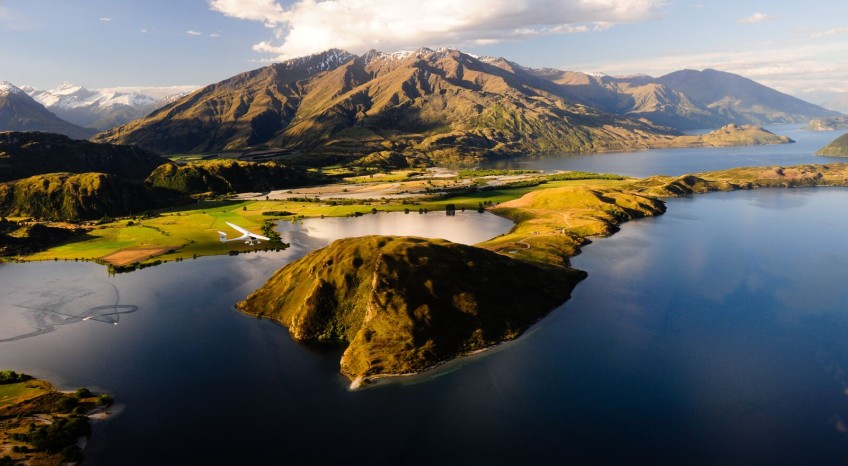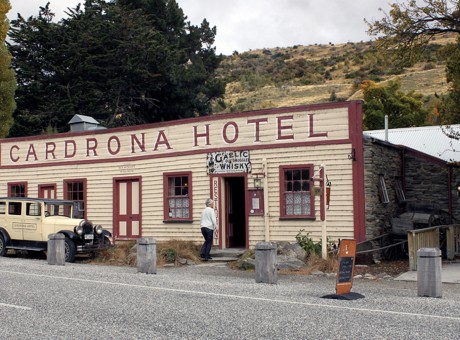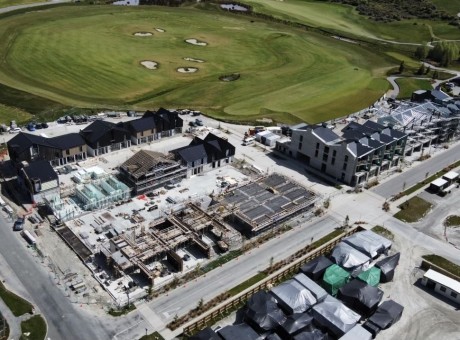Wanaka airport expansion. Is 20 years of planning an unstoppable force?

Opinion. Wanaka resident Andrew Waterworth takes a detailed, investigative look at the background to the proposed major expansion of Wanaka Airport.
Wouldn’t it be great to have a commercial airport in Wanaka! Fancy flying direct to Christchurch, Auckland, Wellington – maybe even Australia. No more driving over the Crown Range, dodging through the Frankton traffic, hustling with the Queenstown parking and airport crowds. Sounds brilliant doesn’t it. So handy and convenient. And grown-up! Our very own airport!

Andrew Waterworth
Hang on a minute – let’s just think this through. What does an airport capable of handling commercial jet aircraft actually involve? Why would somebody (who?) spend potentially hundreds of millions of dollars developing Wanaka airport from a General Aviation to commercial passenger airport just to give folks from the Upper Clutha easier access to domestic and maybe international travel?
The short and realistic answer is – they wouldn’t. You only have to look at how Air New Zealand has withdrawn or wound down services to a clutch of smaller towns around New Zealand over the past four years. They’ve stopped flying to Blenheim, Westport, Whakatane, Kaitaia and, earlier this year, the Kapiti Coast. Air New Zealand has also cut some routes to Palmerston North, Taupo, Hamilton, Whangarei and New Plymouth. The reason? They say the services were uneconomical.
So, what makes Wanaka different? Two things – it’s close to Queenstown and it is a tourist destination. What would make it worthwhile investing hundreds of millions of dollars in developing Wanaka airport is tourism and the projected growth in visitors wanting to come to New Zealand over the next 20 plus years. That is how a commercially run airport would recoup its investment and pay dividends to its shareholders.
Queenstown Airport Corporation is the company that has the license to manage the Wanaka airport. They have already acquired land surrounding the existing airport and signed a 100-year lease on Wanaka Airport with QLDC to future proof their options.
What are those options? They could increase the costs of leasing hangar and other space at the airport, increase landing fees and charge more for parking in order to generate an increase in revenue. But tough as that might be for the current leaseholders and operators, it’s not going to generate a huge amount of money and profit.
Much more likely is a plan to develop and upgrade Wanaka airport to become a commercial jet aircraft operation. The overall intention is pretty clear from the QAC’s Statement of Intent 2019-2021:
"Our vision is to position Queenstown and Wanaka Airports collectively as a World Leading Tourism Airport Group, taking full advantage of the region’s appeal as a leisure and visitor destination."
The QAC is currently undertaking a Wanaka Airport Masterplan which it says will be completed by September 2019. It will then be open to public consultation, to be completed by June 2020. It seems highly unlikely that the QAC would spend that amount of time and money to investigate the future business strategy for Wanaka Airport if they didn’t expect to come up with something significantly more ambitious and profitable than its current status, servicing the needs of general aviation, tourist flights and NASA.
That is especially so when you consider recent events in Queenstown, where in the face of a community backlash against QAC proposals to expand the noise boundaries and increase the airport’s capacity, the QAC was forced to back down and withdraw the noise boundary application to the QLDC.

Queenstown Airport Corporation CEO Colin Keel
The QAC’s immediate response came from CEO Colin Keel who said that they would advance with work on their Wanaka Airport Masterplan while considering other key long-term planning initiatives. It’s reasonable to assume that QAC intend to direct the Wanaka Airport Master Plan more forcibly towards an option which allows for commercial jet aircraft to land in Wanaka, in order to accommodate the overflow from Queenstown.
That’s especially so since the QAC has made its preferences clear in its 2017 report: Queenstown Airport Master Plan Options – Let’s start talking about tomorrow. The report examines various options for managing the unexpectedly rapid growth of Queenstown airport and its capacity to handle the increasing number of visitors over the next 30 years.
The report states that by 2025, passenger movements through Queenstown Airport could reach 3.2 million (visitors/residents), and 25,000 aircraft movements a year. QAC projects that on a peak day that equates to 1,580 international passengers coming and going, and 13 aircraft movements, an hour.
Looking out to 2045, the report’s analysis shows potential demand of around 7 million passenger movements (3.5 million visitors/residents) each year by 2045. QAC believes about 5 million passenger movements (2.5 million visitors/residents) per year is more sustainable for Queenstown Airport (although that now looks questionable in the face of strong opposition to its noise boundary expansion application).
That suggests a deficit in capacity of 2 million passenger movements a year. A Wanaka airport operating as a dual airport with Queenstown looks an attractive option to QAC to pick up the shortfall.
On page 36 of the report, it poses the question under the heading New Airport - Should we move the airport? The report considers 20 locations for establishing a new airport but swiftly reduces those to two: Wanaka /Hawea Downs to the north, Five Rivers/Mossburn to the south. The report evaluates but then dismisses this idea for a number of reasons as being impractical and proceeds to the next proposition on page 39, titled: Dual Airport – What about Wanaka?
"We see Wanaka as a key element of a “one airport business, two complementary airports” approach to support economic growth across the region."
And in the report’s summary, QAC states:
"Dual airport option - we intend to pursue the dual complementary airport model with Queenstown and Wanaka airports. Once the long-term lease is finalised with QLDC, we will work with the community on future development plans for Wanaka Airport."

Queenstown residents were over 90% opposed to airport expansion in QAC's own submission process. Public meetings like this one in Frankton showed almost universal opposition to Queenstown airport expansion.
You might say – that’s all very well for QAC to work with the community on future development plans – but they are a company with vested commercial interests, 24.99% owned by Auckland Airport. QAC is not an elected body answerable to the ratepayers or communities of the Southern Lakes District.
QAC is run by a board of directors whose responsibility is to deliver positive commercial results for their shareholders.
That is clear in their Statement of Intent 2019-2021 – a report that goes to the QLDC for comment and consultation before being submitted to the QAC board, in accordance with the Local Government Act 2002.
The QAC Statement of Intent 2019-21 was approved by the QAC Board on 5 June 2018 and it says:
"QAC’s business success and growth is intrinsically linked to the health of New Zealand’s tourism and visitor industry. In turn, the industry depends on Queenstown and Wanaka airports to provide sustainable air connectivity and a world-class visitor experience to support its tourism industry goal of achieving $41 billion annual revenue by 2025."
Yes, the QLDC is the majority shareholder with a 75.01% stake in QAC but that doesn’t absolve the QLDC from independently consulting its constituency on the larger issues of whether they want a commercial jet aircraft airport on their doorstep.

At this point it helps if we take a step back in time and look at the history of what has been investigated, reported and consulted over the ten years. You may be surprised by what has already gone on, been studied and concluded.
Timeline
2008
- 11th Sep 2008. Wanaka Airport Master Plan prepared for the Wanaka Airport Management Committee by Peak Projects and the then Airport Manager.
2009
- QAC was engaged by Queenstown Lakes District Council to manage Wanaka Airport’s day-to-day operations.
2010
- QAC commences management of day-to-day operations at Wanaka Airport
2013
- Wanaka Airport Land Use Study prepared by Airbiz. This report reviewed the 2008 Master Plan and identified potential aviation related commercial activities that could expect to be provided at the airport on current airport land and on adjacent land that may need to be rezoned for airport related activities.
- Christchurch Airport's terminal revamped at a cost of $237 million (New Zealand's second largest airport with a record 6.57 million passenger movements in the 2017 financial year)
- Christchurch Airport chief executive Jim Boult announced in May he will leave the role at the end of the year. Mr Boult came off the airport company's board almost five years previously to work as acting CEO.
2014
- Notice of Requirement (NoR) to modify the Airport Purposes Designation. This NoR seeks to include the strip of land, currently owned by the Toy and Transport Museum in the airport land holding to provide for a parallel taxiway.
2015
- Auckland Airport (which owns 24.99% of QAC) releases it document, Airport of the Future – Our Vision for the next 30 Years. The report states:
‘In the next ten years the number of passengers flying in and out of Auckland each year could almost double to 24 million passengers, and in the next thirty years we expect the number of passengers to triple to forty million…. The number of flights in and out of Auckland every year is expected to nearly double to 260,000 in 2044.’
In an accompanying video to the Airport of the Future, published on 12th August 2015, it says:
‘By 2030, two thirds of the global middle class will live in Asia Pacific. That’s over 3 billion people. We’re a hub in the middle of that growth’.
- At its meeting on 5 Oct 2015 the QLDC/QAC steering group endorsed the role of Wanaka airport as a supplementary and complementary facility to Queenstown Airport.
2016
- Wanaka Airport Planning and Development report prepared for Queenstown Lakes District Council and Queenstown Airport Corporation by Astral Limited is delivered on 20 April. The report assesses the financial and logistical status and potential for Wanaka airport and recommends two options for future ownership and management.
- At a meeting on 28 April 2016, the Council considered the Astral Limited report. Council instructed officers to investigate the governance options and report back to Council on a preferred governance model for Wanaka Airport for consideration by Council.
- Consultants from Rationale Limited were engaged to assist with the development of possible options at the initial stage of developing the business case.
- The Rationale business case supports changes to the current governance and management structure. It analyses the advantages and disadvantages of the five considered options together with high level modelling of the commercial and financial cases. The preferred option is a long-term lease and management arrangement with QAC.
- The options were then workshopped by the Council and the Wanaka Community Board (WCB) at a meeting on 12 July 2016.
- TheAstral Report andRationale business case identified that strategicallythe airport ought to run as a complementary and supplementary facility to Queenstown Airport. QLDC and the Wanaka Community Board noted that Wanaka Airport could become a base for general aviation services, and that scientific services, such as the NASA balloon programme, could become important. If planned and managed well, there was an opportunity for growth and development of the Airport, both to increase services to Wanaka residents, butalso to reduce pressure on Queenstown Airport.
This is all discussed by QLDC on 29th September where the council determines that a Special Consultative Procedure (SCP) is required to help determine the Wanaka Airport future governance and management model, since “Wanaka Airport is listed as a Strategic Asset. The policy states that any decision that transfers or changes control of strategic assets is a significant matter and will trigger the Special Consultative Procedure (SCP) contained in the Local Government Act 2002 (LGA).”
- October 2016, the QLDC puts out a consultation document: Statement of Proposal. Wanaka Airport – A Long Term Lease? In the summary, it says: ‘The Council’s preferred option is to enter into a long term lease and management arrangement with Queenstown Airport Corporation Ltd (QAC), which is a council controlled trading organisation. The lease would be structured to incentivise investment by QAC in Wanaka Airport to enable the Airport to meet the projected growth in the District’s air services over the next decade or longer.’
The consultation document goes on to say: ‘At the moment Wanaka Airport has a modest income stream of about $230,000 a year before interest and tax, largely from landing fees and ground rents. The Council’s long-term plan has a total capital programme of $396M, of which $1.5M relates to Wanaka Airport. Capital expenditure at the Airport depends on other core Council priorities such as network infrastructure. This level of investment is reactive only and is required to maintain existing infrastructure. It is insufficient to achieve the development required over the next decade or more to provide for the expected growth of the Airport.’
The document continues: under the heading of FUTURE GROWTH: Demand for air services across the District is increasing. Land and planning constraints make further expansion of Queenstown Airport difficult. At the same time, under its present governance structure, there is little incentive for the capital expenditure necessary to attract aviation services to Wanaka Airport. This review provides a significant opportunity for Wanaka Airport to grow. If planned and managed well, this could provide increased services to the Wanaka area and also reduce pressure on Queenstown Airport.
- Submissions on the consultative procedure closed on 25th November
- 9th December, the Queenstown Airport Corporation announced the "strategic" and "critical" purchase of 106 hectares of land next to Wanaka airport. QAC Chairman John Gilks is reported in the media as saying the purchase is not a joint venture with the Queenstown Lakes District Council. Referring to QAC’s tenure over Wanaka airport, Gilks was reported as saying: ‘"There is no incentive for us to invest unless we have got long term tenure. If we can get long term tenure we have development plans for Wanaka Airport. We would really like to run it under a strategy of one company, two airports,"
Gilks went on to say, "..we do know there are new opportunities at Wanaka Airport and there's the separate opportunity to share some of the facilities with Queenstown. Queenstown is constrained and is going to be more and more constrained. What we would like to do is reposition, as much as we can, the services between the two airports".
2017
- 2nd March, Queenstown Airport Corporation confirmed it had acquired Windermere Farm, a 43 hectare block of land located adjacent to Wanaka Airport. The land adjoins the runway to the north east of Wanaka Airport.
- 10th March QAC Chairman John Gilks was reported in the media as saying the region was likely to experience growth over the next 30 years and that Queenstown Airport was restricted in its ability to accommodate it. "As demand for services grows some of that will be able to be relocated to Wanaka but it's too soon to get into any further detail on that."
- April 2017Queenstown Lakes District Council confirmed that it had finalised the terms of a long-term lease with Queenstown Airport Corporation for Wanaka Airport.The grant of the lease to QAC was decided on by QLDC after it considered several ownership, governance and management options for Wanaka Airport and formally consulted with the community in November 2016.
- August 2017, QAC released its Masterplan Options – Let’s Start Talking about Tomorrow. In this report it investigates options and opportunities for future growth and expansion, including how Queenstown airport can be expanded, whether a new airport should be considered and concluding that a Dual Airport strategy combining Queenstown and Wanaka airports in a“one airport business, two complementary airports” approach to support economic growth across the region is the best option.
The report highlights some eye-popping numbers: While our analysis shows potential demand of around 7 million passenger movements (3.5 million visitors/residents) each year by 2045, we believe about 5 million passenger movements (2.5 million visitors/residents) per year is moresustainable for Queenstown Airport.
Local media asked whether that means Wanaka Airport is being groomed to handle the additional 2 million passenger movements per year.
- 7th December 2017 – media report QAC welcoming a community-fostered vision to develop Wanaka Airport as a “sustainable aviation hub for the region”. Recommendations on how to achieve this goal were released as part of the Shaping Our Future Upper Clutha Transport taskforce, which developed a vision for the region’s transport industry looking to 2050 and beyond. The vision for air connectivity was defined as “Wanaka Airport is a destination for high yielding innovative businesses creating a sustainable aviation hub for the region.”
2018
- Early 2018 Queenstown Airport Corporation announced a proposal to expand the capacity of Queenstown Airport. Media report that QAC CEO Colin Keel states the proposed expansion to the air noise boundary would enable 41,600 scheduled aircraft movements (take-offs or landings) a year by 2045, equivalent to just over five million passengers, around 2.5 times the airport’s current operating capacity. The current air noise boundary allows for 21,000 scheduled aircraft movements. The airport says this limit is forecast to be reached in the next three to four years.
- 21st Mar 2018, QLDC confirmed that it had finalised the terms of a $14.5million 100-year lease with Queenstown Airport Corporation for Wanaka Airport. The lease transfers the operation, planning, development and governance of the airport to QAC. QAC Chief Executive Colin Keel states, “As the new custodians of Wanaka Airport we look forward to working with key stakeholders and the communities we serve in shaping the future vision of the airport and building on this heritage.The long-term lease provides QAC with confidence to invest in, plan and develop the airport as important infrastructure for regional aviation growth”.
- 1st April, the 100-year lease on Wanaka Airport commenced.
- On 21st and 22ndMay, QAC held two community engagement workshops in Wanaka under the title, Wanaka Airport 2045. The interactive sessions were designed to help people work through a series of questions to understand what the future Wanaka Airport could look like over the next 30 years.
- 25th May, QAC thanked the more than 140 members of the Upper Clutha communities who were asked to “dream big” at the two workshops
- QAC released its Wanaka Airport Welcome Brochure which states that with the new long-term lease in place, QAC is able to begin planning and developing Wanaka Airport. The report says ‘planning is key as Wanaka’s resident population is forecast to increase to over 25,357 by 2058, compared to 12,491 today. This is in addition to the over 56,712 visitors – an increase on 34,448 today (based on a peak day)*. Opportunities include the expansion of current commercial businesses, return of scheduled services, or the development of other growth areas such as a centre of aviation excellence.’
- 5th June 2018, the QAC Board approved the Statement of Intent 2019-21.The report is a statutory requirement, as it explains: ‘As a Council-Controlled Trading Organisation, Queenstown Airport Corporation (QAC) is required to prepare an annual Statement of Intent (SOI) which publicly states its strategic priorities for the next three years in accordance with Section 64(1) of the Local Government Act 2002. The SOI takes shareholder comments into consideration and provides performance targets for organisational accountability.’
- Early August, a strong push-back from the Queenstown business and resident communities against boosting visitor numbers. Media reported that ‘influential business leader Sir Eion Edgar has emailed his powerful network saying that he believes that Queenstown airport is at FULL CAPACITY (his capital letters) and that any future expansion of the airport should be opposed. "They are wanting to increase passenger numbers from two million to five million. We do not have the infrastructure and the noise will be soul destroying. Let's go for Quality not Quantity."
- 20th August, community consultation finished on QAC’s proposed expansion to noise boundaries for Queenstown airport
- 22nd August, QAC announced its financial results for 2017/18. Passenger demand and increased air capacity underpinned a solid annual performance. Highlights were:
- Revenue up 17% to $45.7 million
- Underlying profit up 21% to $14.9 million
- Reported profit up 24% to $14.9 million
- Aeronautical revenue up 14% and commercial revenue up 21%
- Over $4 million invested in safety, customer experience, innovation and technology
- $14.5 million invested in 100-year long-term lease for Wanaka Airport
- Growth in passenger numbers to 2,140,669 up 13%
- Annual dividend of $7.2 million paid to shareholders Queenstown Lakes District Council (QLDC) and Auckland Airport (AIAL)
- This equates to $5.4 million returned to the Queenstown Lakes District community- $215 per rateable property in the district.
- 14th September Air New Zealand made public its submission on QAC’s proposed expansion of Queenstown airport’s noise boundaries with its own proposal for a new Central Otago airport, together with criticism of Auckland Airport, saying “Auckland Airport has been late to invest in its infrastructure and wider landholding, leading to services into and out of Auckland Airport being significantly constrained.” And further suggesting: “Air New Zealand would encourage QAC to engage with central government, local government and airlines on options for delivery of tourism to central Otago, independently of the discussion of noise boundaries at QAC.”
- 23rd September - media report University of Otago business school tourism professor, Juergen Gnoth saying that a national tourism strategy is well overdue, and that he is dubious about the need for a new regional airport. Gnoth is quoted saying "I personally don't think it is yet viable because building an airport is one thing, having the infrastructure around it is another. What it shows is that we're having capacity problems and that we've been falling asleep at the wheel for the past 20 years.”
- 1st October, Mitchell Daysh delivered their report to QAC on the Summary of Public Consultation Outcomes on the proposed expansion of Queenstown airport noise boundaries. The response from the 1500 respondents is overwhelmingly negative, 92.5% are opposed to the proposed expansion of airport noise boundaries. The report concludes that:
‘Reasons for opposition vary, but are broadly due to: The additional adverse effects (particularly noise) that will result from further air traffic movements, and; Opposition to the effects of additional visitors to Queenstown more generally.’ The report also noted that: ‘The majority disagree that planning for growth in passenger numbers to 5.1 mppa (million passenger per annum) will have a positive effect for the local and regional economy: Many respondents indicated they see no benefits from the growth in passenger numbers proposed’.
- 2nd October, a group opposing the QAC’s proposed noise boundary expansion and consequent increase in flights and visitor numbers issued a media release headlined: “Time for us to drive our future”. The media release by the Queenstown Stakeholders Group states its view that: “It’s not the airport’s job to define our future.”The media release accompanied a submission to the QLDC urging it to fulfil its statutory role and function, “ensuring decisions about growth are well researched and planned and above all else, sustainable.”
- 2nd October, QAC issued a press release, headlined: ‘Proposed noise boundary changes realigned with other planning work.’ Confronted with a majority of the 1500 responses to its community consultation on its noise boundary expansion opposed to the proposal, the QAC advised its next steps: ‘After considering community and stakeholder feedback regarding its proposed changes to Queenstown Airport’s noise boundaries, Queenstown Airport Corporation (QAC) will advance its Wanaka Airport master plan work and consider other key long-term planning initiatives before progressing its noise change proposal to the next stage.’
All this raises a number of questions for residents and ratepayers in Wanaka, the Upper Clutha and district wide.

Here are few to get the discussion going:
Wanaka Airport Master Plan – questions and issues
- The QLDC formally consulted with the Wanaka community in November 2016 on the airport governance options. What was the feedback?
- What real and effective feedback could have been assessed and considered between 25th November 2016 when submissions closed and 9th December 2016, when Queenstown Airport Corporation (QAC) purchased 106 hectares of land surrounding the airport to future proof against further development?
- The QAC consulted with the Wanaka community in May 2018 in a “series of interactive community and stakeholder engagement sessions”. Yet significant deals and commitments had already been made – with the QAC acquiring a further 43 hectares of land adjacent to the airport in March 2017 and signing the $14.5 million lease with the QLDC in March 2018?
- Reported in local media on 10th August 2018, QAC communications manager Jen Andrews said: “The Wanaka public has already been consulted over the future of their airport, and the ''master plan process'' begins next month.” Do we know what the so-called Wanaka community consultation yielded, how many were consulted and what did they say?
- How much sense does it make to have an overflow airport for Queenstown located in Wanaka?
- Passengers bound for Queenstown will have to cross the Crown Range – not an easy or safe road for new arrivals, unsuitable for larger campervans and dangerous in winter.
- Can Cardrona Valley and the Crown Range roads accommodate the increase in traffic from the potential 2 million passenger movements in and out of Wanaka?
- NZ National Transport Agency would need to plan and budget for the major upgrade to roading that would likely be required between Wanaka and Queenstown – would they have the resources to do that?
- How will the Wanaka airport expansion be funded? The 2016 Astral Report commissioned by QLDC and QAC states: Capital works and funding: ‘Significant CAPEX will be required over the next 15 years largely to fund land acquisition and infrastructure development, as well as for asset maintenance and upgrade. Revenue will not be adequate to fund this programme and a considerable debt or equity injection from the shareholder will be required.’ (See also Pages 21/22 on Land Acquisition and Page 22 on need to install mains sewage and water. The report also states: “the Airport currently has insufficient equity and leverage to fund a large asset purchase or major maintenance. For example, the runway resealing in 2008 was funded by an internal loan from QLDC."
- How will Wanaka Airport fulfil the requirements of safety – eg 300 metre wide strip for air transport operations, as recommended in the Astral Report (Page 9): ‘Developments in satellite based navigation technology for aircraft approaches have made application of the international standard of a 300m wide runway strip more relevant, whereas the Master Plan was based on a continuation of the lesser New Zealand Civil Aviation standard of 150m. In light of this development Astral now recommends wherever possible protecting a 300m wide strip for air transport operations.Due to the location of the waste water treatment plant a 300m strip cannot be implemented with the proposed replacement parallel runway alignment included in the 2008 Master Plan.’
- What would happen to the Project Pure sewage treatment plant next to the current runway and which discharges waste grey water onto the green areas beside the runway?
- What would happen to the proposed “Queenstown Lakes District Council’s 10-year planned “$12 million of funding to pipe Lake Hawea sewage to the council’s Project Pure treatment plant next to Wanaka Airport,” reported in local media.
- What rezoning of the land acquired or leased now, and in the future, needed to satisfy the requirements of the proposed expansion and not currently designated for airport use, would be necessary? See Astral report pages 23/24
- What would be the impact of a commercial airport operating as dual airport hub with Queenstown on the communities of Luggate and Albert Town?
- What are the anticipated flightpaths for jet aircraft in and out of Wanaka Airport? What communities and amenities would they track over and at what altitude?
- If Wanaka is a major destination for many of the projected 1 million passengers (two million passenger movements) through Wanaka Airport, where will they stay? Where will the inevitable 4 and 5 star hotels be built?
- What thought, consultation and planning has the QLDC put into the larger issues of whether Wanaka can handle the additional growth in tourism and development associated with the Wanaka Airport becoming a dual airport hub with Queenstown?
- In reviewing Wanaka’s Integrated Transport Programme Business Case and Town Centre MasterPlan, what level of growth is council factoring into the plan?
- The QLDC is committed to ensure sustainable management of the District’s special features and qualities:
- Dramatic alpine landscapes free of inappropriate development
- Clean air and pristine water
- Vibrant and compact town centres
- Compact and connected settlements that encourage public transport, biking and walking
- Diverse, resilient, inclusive and connected communities
- A district providing a variety of lifestyle choices
- An innovative and diversifying economy based around a strong visitor industry
How can these be maintained while accommodating an expansion of Wanaka Airport’s capabilities to handle commercial jet aircraft and to cater for potentially 2 million passenger movements a year?
Declared Interest: I am a member of the Wanaka Stakeholders Group which is established:
➢ to raise awareness in the Upper Clutha community about the proposed re-development of Wanaka Airport
➢ to discuss the likely long-term impact of such development on this area.


























